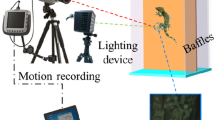Abstract
Scanning electron microscopy (SEM) and histological techniques were used to observe and study the setae structures of two gecko species (G. gecko and G. swinhonis) and the relationships between these structures and the adhesive forces. The SEM results showed that the setae of these two species were densely distributed in an orderly fashion, and branched with curved tips. The setae of G. gecko had cluster structures, each cluster containing 4–6 setae whose terminal branches curved towards the center of the toes at ∼ 10°, the tips of the branches like spatulae and densely arrayed at an interval of less than 0.2–0.3 μm. On the contrary, the branch tips in the setae of G. swinhonis were curled, and the terminal parts of setae curved towards the center of the toes at various angles. Usually the setae of these gecko species branch twice at the top at intervals greater than that of G. gecko. The histological observation found that inside the setae of these two species there were plenty of unevenly distributed contents, such as epithelia, fat cells, pigmental cells and muscle tissue, but no gland cells existed. The results of functional experiments suggested that modifying the structure of gecko’s setae could reduce its adhesive ability dramatically, demonstrating the positive correlation between the structure of the gecko’s setae and its adhesive ability. The above results provide important information in designing bio-mimic setae and bio-gecko robots.
Similar content being viewed by others
References
Li L H. Application research information about special type robots in UK. Robots Inform (in Chinese), 1992, 3: 2342–2347
Autumn K, Liang Y A, Hsieh S T, et al. Adhesive force of a single gecko foot-hair. Nature, 2000, 405: 681–685, 10864324, 10.1038/35015073, 1:CAS:528:DC%2BD3cXktlCgu7g%3D
Autumn K, Sitti M, Liang Y A, et al. Evidence for van der Waals adhesion in gecko setae. Proc Natl Acad Sci USA, 2002, 99(19): 12252–12256, 12198184, 10.1073/pnas.192252799, 1:CAS:528:DC%2BD38XntlCks7o%3D
Bundle M W, Dial K P. Mechanics of wing-assisted incline running (Wair). J Exp Biol, 2003, 206(24): 4553–4564, 14610039, 10.1242/jeb.00673
Gorb S N, Beutel R G., Gorb E V, et al. Structural design and biomechanics of friction-based releasable attachment devices in insects. Integr Comp Biol, 2002, 42(6): 1127–1139, 10.1093/icb/42.6.1127
Desiraju G R. Chemistry beyond the molecule. Nature, 2001, 412(6845): 397–400, 11473302, 10.1038/35086640, 1:CAS:528:DC%2BD3MXlslCruro%3D
Gee H. Biomechanics-Gripping feat. Nature, 2000, 405(6787): 631–631, 10.1038/35015203, 1:CAS:528:DC%2BD3cXktlCjurk%3D
Federle W, Endlein T. Locomotion and adhesion: Dynamic control of adhesive surface contact in ants. Arthropod Struct Dev, 2004, 33, 67–75, 10.1016/j.asd.2003.11.001
Zaaf A, Damme R V, Herrel A, et al. Spatio-temporal gait characteristics of level and vertical locomotion in a ground-dwelling and a climbing gecko. J Exp Biol, 2001, 204(7): 1233–1246, 11249834, 1:STN:280:DC%2BD3MvjsVCktw%3D%3D
Zaaf A, Damme R V. Limb proportions in climbing and grounddwelling geckos (Lepidpsauria, Gekkonidae): A phylogenetically informed analysis. Zoomorphology, 2001, 121(1): 45–53, 10.1007/s004350100044
Zaaf A, Herrel A, Aerts P, et al. Morphology and morphometrics of the appendicular musculature in geckoes (Lepidosauria) with different locomotor habits. Zoomorphology, 1999, 119(1): 9–22, 10.1007/s004350050077
Sun J R, Guo C, Cheng H, et al. Comparison of the setae between the dung beetle Copris ochus and the gecko G. gecko and the effects of deformation on their functions. Acta Zool Sin (in Chinese), 2005, 51(4): 761–767
Cheng H, Sun J R, Li J Q, et al. Structure of the integumentary surface of the dung beetle Copris ochus Motschulsky and its relation to non-adherence of substrate particles. Acta Entomol Sin (in Chinese), 2002, 45(2): 175–181
Cheng H, Chen M S, Sun J R. Histological structure of the dung beetle Copris ochus Motschulsky integument. Acta Entomol Sin (in Chinese), 2003, 46(4): 429–435
Alibardi L. Ultrastructural autoradiographic and immunocytochemical analysis of setae formation and keratinization in the digital pads of the gecko Hemidactylus turcicus (Gekkonidae, Reptilia). Tissue Cell, 2003, 35: 288–296, 12921711, 10.1016/S0040-8166(03)00050-8, 1:STN:280:DC%2BD3szos1Ghtw%3D%3D
Sitti M, Fearing R S. Synthetic gecko foot-hair micro/nano-structures as dry adhesives. J Adhes Sci Technol, 2003, 18(7): 1055–1074, 10.1163/156856103322113788
Sitti M, Fearing R S. Nanomolding based fabrication of synthetic gecko foot-hairs. In: Proceedings of IEEE Conference on Nanotechnology. Washington DC, 2002. 26–28
Geim A K, Dubonosl S V, Grigorieval I V, et al. Microfabricated adhesive mimicking gecko foot-hair. Nature Materials, 2003, 2: 461–463, 12776092, 10.1038/nmat917, 1:CAS:528:DC%2BD3sXls1els7k%3D
Author information
Authors and Affiliations
Corresponding authors
Additional information
Supported by the National Natural Science Foundation of China (Grant Nos.30400086, 30470230 and 60535020)
Rights and permissions
About this article
Cite this article
Guo, C., Wang, W., Yu, M. et al. Comparative studies on the structure and adhesion of setae in G. gecko and G. swinhonis. SCI CHINA SER C 50, 831–838 (2007). https://doi.org/10.1007/s11427-007-0093-2
Received:
Accepted:
Published:
Issue Date:
DOI: https://doi.org/10.1007/s11427-007-0093-2




